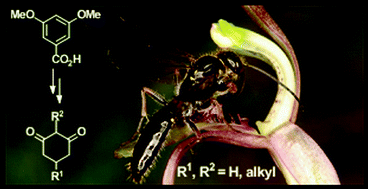
The Australian orchid Chiloglottis trapeziformis' very existence hinges upon there being some truth to the old adage that love is blind. Unlike other flowers, which lure pollinators with nectar, C. trapeziformis attracts its pollinator, the thynnine wasp Neozeleboria cryptoides, by producing the same pheromone that the insects use to attract the opposite sex–a practice known as sexual deception. Fooled by the pheromone, the male wasp will try to mate with the orchid. But ultimately it leaves the encounter with nothing more than a fine coat of pollen that it carries to its next liaison with a sexually deceptive orchid.
A five-step synthesis of monoalkyl- and 2,5-dialkyl-1,3-cyclohexanediones (1) is described viaa sequence involving sequential Birch reductions and alkylations from the readily accessible and inexpensive starting material, 3,5-dimethoxybenzoic acid. Two approaches were considered in which alkylation at C-2 occurs either prior or subsequent to the proposed reduction. The successful route, in which Birch reduction of a 3-alkyl resorcinol derivative (3) precedes alkylation was applied in the synthesis of chiloglottone 1 (1dc), in 58% overall yield.
(2-ethyl-5-propylcyclohexan-1,3-dione),
DOI: 10.1039/B912233H

Identification of the First Alkenyl Chiloglottone Congener

Chiloglottone 4, a plant allomone and insect pheromone, has been identified through synthesis. Field studies have shown it to be the biologically potent floral volatile in the orchid Chiloglottis turfosa attracting the wasp pollinator Neozeleboria sp.
http://onlinelibrary.wiley.com/doi/10.1002/ejoc.201200795/abstract